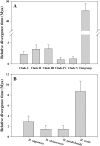Genetic identification and evolutionary trends of the seagrass Halophila nipponica in temperate coastal waters of Korea
- PMID: 28505209
- PMCID: PMC5432184
- DOI: 10.1371/journal.pone.0177772
Genetic identification and evolutionary trends of the seagrass Halophila nipponica in temperate coastal waters of Korea
Abstract
Although seagrass species in the genus Halophila are generally distributed in tropical or subtropical regions, H. nipponica has been reported to occur in temperate coastal waters of the northwestern Pacific. Because H. nipponica occurs only in the warm temperate areas influenced by the Kuroshio Current and shows a tropical seasonal growth pattern, such as severely restricted growth in low water temperatures, it was hypothesized that this temperate Halophila species diverged from tropical species in the relatively recent evolutionary past. We used a phylogenetic analysis of internal transcribed spacer (ITS) regions to examine the genetic variability and evolutionary trend of H. nipponica. ITS sequences of H. nipponica from various locations in Korea and Japan were identical or showed very low sequence divergence (less than 3-base pair, bp, difference), confirming that H. nipponica from Japan and Korea are the same species. Halophila species in the section Halophila, which have simple phyllotaxy (a pair of petiolate leaves at the rhizome node), were separated into five well-supported clades by maximum parsimony analysis. H. nipponica grouped with H. okinawensis and H. gaudichaudii from the subtropical regions in the same clade, the latter two species having quite low ITS sequence divergence from H. nipponica (7-15-bp). H. nipponica in Clade I diverged 2.95 ± 1.08 million years ago from species in Clade II, which includes H. ovalis. According to geographical distribution and genetic similarity, H. nipponica appears to have diverged from a tropical species like H. ovalis and adapted to warm temperate environments. The results of divergence time estimates suggest that the temperate H. nipponica is an older species than the subtropical H. okinawensis and H. gaudichaudii and they may have different evolutionary histories.
Conflict of interest statement
Figures




Similar articles
-
Morphological and genetic identification of Halophila species and a new distribution record of Halophila nipponica at the Tanjung Adang Laut shoal, Johor, Malaysia.PLoS One. 2024 Oct 3;19(10):e0309143. doi: 10.1371/journal.pone.0309143. eCollection 2024. PLoS One. 2024. PMID: 39361582 Free PMC article.
-
Genetic identification and hybridization in the seagrass genus Halophila (Hydrocharitaceae) in Sri Lankan waters.PeerJ. 2020 Sep 30;8:e10027. doi: 10.7717/peerj.10027. eCollection 2020. PeerJ. 2020. PMID: 33062439 Free PMC article.
-
Analysis of rDNA reveals a high genetic diversity of Halophila major in the Wallacea region.PLoS One. 2021 Oct 22;16(10):e0258956. doi: 10.1371/journal.pone.0258956. eCollection 2021. PLoS One. 2021. PMID: 34679102 Free PMC article.
-
Taxonomy of the Genus Halophila Thouars (Hydocharitaceae): A Review.Plants (Basel). 2020 Dec 8;9(12):1732. doi: 10.3390/plants9121732. Plants (Basel). 2020. PMID: 33302504 Free PMC article. Review.
-
Genetic species identification and population structure of Halophila (Hydrocharitaceae) from the Western Pacific to the Eastern Indian Ocean.BMC Evol Biol. 2014 Apr 30;14:92. doi: 10.1186/1471-2148-14-92. BMC Evol Biol. 2014. PMID: 24886000 Free PMC article.
Cited by
-
Morphological and genetic identification of Halophila species and a new distribution record of Halophila nipponica at the Tanjung Adang Laut shoal, Johor, Malaysia.PLoS One. 2024 Oct 3;19(10):e0309143. doi: 10.1371/journal.pone.0309143. eCollection 2024. PLoS One. 2024. PMID: 39361582 Free PMC article.
-
Current advances in seagrass research: A review from Viet Nam.Front Plant Sci. 2022 Oct 10;13:991865. doi: 10.3389/fpls.2022.991865. eCollection 2022. Front Plant Sci. 2022. PMID: 36299785 Free PMC article. Review.
-
Genetic identification and hybridization in the seagrass genus Halophila (Hydrocharitaceae) in Sri Lankan waters.PeerJ. 2020 Sep 30;8:e10027. doi: 10.7717/peerj.10027. eCollection 2020. PeerJ. 2020. PMID: 33062439 Free PMC article.
-
Analysis of rDNA reveals a high genetic diversity of Halophila major in the Wallacea region.PLoS One. 2021 Oct 22;16(10):e0258956. doi: 10.1371/journal.pone.0258956. eCollection 2021. PLoS One. 2021. PMID: 34679102 Free PMC article.
-
Taxonomy of the Genus Halophila Thouars (Hydocharitaceae): A Review.Plants (Basel). 2020 Dec 8;9(12):1732. doi: 10.3390/plants9121732. Plants (Basel). 2020. PMID: 33302504 Free PMC article. Review.
References
-
- den Hartog C. The sea-grasses of the World. North-Holland, Amsterdam; 1970.
-
- Les DH, Cleland MA, Waycott M. Phylogenetic studies in Alismatidae, II: Evolution of marine angiosperms (seagrasses) and hydrophily. Syst Bot. 1997; 22: 443–463.
-
- Waycott M, Procaccini G, Les DH, Reusch TBH. Seagrass evolution, Ecology and Conservation: a genetic perspective In: Larkum AWD, Orth RJ, Duarte CM, editors. Seagrasses: Biology, Ecology and Conservation. Springer, the Netherland; 2006. pp. 25–50.
-
- McRoy CP, McMillan C. Production ecology and physiology of seagrasses In: McRoy CP, Helfferich C, editors. Seagrass ecosystems: a scientific perspective. Dekker, New York; 1997. pp. 53–81.
MeSH terms
Substances
LinkOut - more resources
Full Text Sources
Other Literature Sources
Miscellaneous

